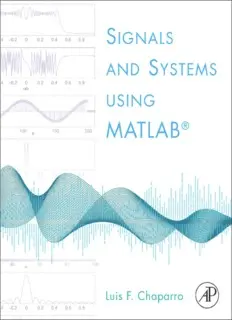Table Of Content
Signals and Systems
Using MATLAB
Luis F. Chaparro
Department of Electrical and Computer Engineering
University of Pittsburgh
AMSTERDAM•BOSTON•HEIDELBERG•LONDON
NEWYORK•OXFORD•PARIS•SANDIEGO
SANFRANCISCO•SINGAPORE•SYDNEY•TOKYO
AcademicPressisanimprintofElsevier
AcademicPressisanimprintofElsevier
30CorporateDrive,Suite400,Burlington,MA01803,USA
Elsevier,TheBoulevard,LangfordLane,Kidlington,Oxford,OX51GB,UK
Copyright(cid:13)c 2011ElsevierInc.Allrightsreserved.
Nopartofthispublicationmaybereproducedortransmittedinanyformorbyanymeans,electronicormechanical,
includingphotocopying,recording,oranyinformationstorageandretrievalsystem,withoutpermissioninwritingfrom
thepublisher.Detailsonhowtoseekpermission,furtherinformationaboutthePublisher’spermissionspoliciesandour
arrangementswithorganizationssuchastheCopyrightClearanceCenterandtheCopyrightLicensingAgency,canbe
foundatourwebsite:www.elsevier.com/permissions.
ThisbookandtheindividualcontributionscontainedinitareprotectedundercopyrightbythePublisher(otherthan
(cid:13)
asmaybenotedherein).MATLABR isatrademarkofTheMathWorks,Inc.andisusedwithpermission.TheMathWorks
(cid:13)
doesnotwarranttheaccuracyofthetextorexercisesinthisbook.ThisbooksuseordiscussionofMATLABR software
orrelatedproductsdoesnotconstituteendorsementorsponsorshipbyTheMathWorksofaparticularpedagogical
(cid:13)
approachorparticularuseoftheMATLABR software.
Notices
Knowledgeandbestpracticeinthisfieldareconstantlychanging.Asnewresearchandexperiencebroadenour
understanding,changesinresearchmethods,professionalpractices,ormedicaltreatmentmaybecomenecessary.
Practitionersandresearchersmustalwaysrelyontheirownexperienceandknowledgeinevaluatingandusingany
information,methods,compounds,orexperimentsdescribedherein.Inusingsuchinformationormethodsthey
shouldbemindfuloftheirownsafetyandthesafetyofothers,includingpartiesforwhomtheyhavea
professionalresponsibility.
Tothefullestextentofthelaw,neitherthePublishernortheauthors,contributors,oreditors,assumeanyliability
foranyinjuryand/ordamagetopersonsorpropertyasamatterofproductsliability,negligenceorotherwise,
orfromanyuseoroperationofanymethods,products,instructions,orideascontainedinthematerialherein.
LibraryofCongressCataloging-in-PublicationData
Chaparro,LuisF.
(cid:13)
SignalsandsystemsusingMATLABR/LuisF.Chaparro.
p.cm.
ISBN978-0-12-374716-7
1.Signalprocessing–Digitaltechniques.2.Systemanalysis.3.MATLAB.I.Title.
TK5102.9.C4722010
621.382’2–dc22
2010023436
BritishLibraryCataloguing-in-PublicationData
AcataloguerecordforthisbookisavailablefromtheBritishLibrary.
ForinformationonallAcademicPresspublications
visitourWebsiteatwww.elsevierdirect.com
PrintedintheUnitedStatesofAmerica
10 11 12 13 9 8 7 6 5 4 3 2 1
To my family, with much love.
Contents
PREFACE..................................................................................................................... xi
ACKNOWLEDGMENTS................................................................................................ xvi
Part 1 Introduction 1
CHAPTER0 FromtheGroundUp!............................................................................. 3
0.1 SignalsandSystemsandDigitalTechnologies........................................ 3
0.2 ExamplesofSignalProcessingApplications........................................... 5
0.2.1 Compact-DiscPlayer................................................................ 5
0.2.2 Software-DefinedRadioandCognitiveRadio............................... 6
0.2.3 Computer-ControlledSystems................................................... 8
0.3 AnalogorDiscrete?............................................................................. 9
0.3.1 Continuous-TimeandDiscrete-TimeRepresentations.................. 10
0.3.2 DerivativesandFiniteDifferences ............................................. 12
0.3.3 IntegralsandSummations......................................................... 13
0.3.4 DifferentialandDifferenceEquations......................................... 16
0.4 ComplexorReal?................................................................................ 20
0.4.1 ComplexNumbersandVectors.................................................. 20
0.4.2 FunctionsofaComplexVariable................................................ 23
0.4.3 PhasorsandSinusoidalSteadyState.......................................... 24
0.4.4 PhasorConnection................................................................... 26
0.5 SoftIntroductiontoMATLAB ............................................................... 29
0.5.1 NumericalComputations.......................................................... 30
0.5.2 SymbolicComputations............................................................ 43
Problems............................................................................................ 53
Part 2 Theory and Application of Continuous-Time
Signals and Systems 63
CHAPTER1 Continuous-TimeSignals......................................................................... 65
1.1 Introduction....................................................................................... 65
1.2 ClassificationofTime-DependentSignals............................................... 66
iv
Contents v
1.3 Continuous-TimeSignals..................................................................... 67
1.3.1 BasicSignalOperations—TimeShiftingandReversal................... 71
1.3.2 EvenandOddSignals.............................................................. 75
1.3.3 PeriodicandAperiodicSignals.................................................. 77
1.3.4 Finite-EnergyandFinitePowerSignals...................................... 79
1.4 RepresentationUsingBasicSignals....................................................... 85
1.4.1 ComplexExponentials.............................................................. 85
1.4.2 Unit-Step,Unit-Impulse,andRampSignals................................. 88
1.4.3 SpecialSignals—theSamplingSignalandtheSinc....................... 100
1.4.4 BasicSignalOperations—TimeScaling,FrequencyShifting,
andWindowing....................................................................... 102
1.4.5 GenericRepresentationofSignals.............................................. 105
1.5 WhatHaveWeAccomplished?WhereDoWeGofromHere?.................... 106
Problems............................................................................................ 108
CHAPTER2 Continuous-TimeSystems....................................................................... 117
2.1 Introduction....................................................................................... 117
2.2 SystemConcept.................................................................................. 118
2.2.1 SystemClassification................................................................ 118
2.3 LTIContinuous-TimeSystems.............................................................. 119
2.3.1 Linearity................................................................................. 120
2.3.2 TimeInvariance....................................................................... 125
2.3.3 RepresentationofSystemsbyDifferentialEquations.................... 130
2.3.4 ApplicationofSuperpositionandTimeInvariance ....................... 135
2.3.5 ConvolutionIntegral................................................................. 136
2.3.6 Causality................................................................................ 143
2.3.7 GraphicalComputationofConvolutionIntegral........................... 145
2.3.8 InterconnectionofSystems—BlockDiagrams.............................. 147
2.3.9 Bounded-InputBounded-OutputStability................................... 153
2.4 WhatHaveWeAccomplished?WhereDoWeGofromHere?.................... 156
Problems............................................................................................ 157
CHAPTER3 TheLaplaceTransform............................................................................ 165
3.1 Introduction....................................................................................... 165
3.2 TheTwo-SidedLaplaceTransform........................................................ 166
3.2.1 EigenfunctionsofLTISystems................................................... 167
3.2.2 PolesandZerosandRegionofConvergence ............................... 172
3.3 TheOne-SidedLaplaceTransform........................................................ 176
3.3.1 Linearity................................................................................. 185
3.3.2 Differentiation......................................................................... 188
3.3.3 Integration.............................................................................. 193
3.3.4 TimeShifting........................................................................... 194
3.3.5 ConvolutionIntegral................................................................. 196
vi Contents
3.4 InverseLaplaceTransform................................................................... 197
3.4.1 InverseofOne-SidedLaplaceTransforms................................... 197
3.4.2 InverseofFunctionsContaininge−ρsTerms................................ 209
3.4.3 InverseofTwo-SidedLaplaceTransforms................................... 212
3.5 AnalysisofLTISystems....................................................................... 214
3.5.1 LTISystemsRepresentedbyOrdinaryDifferentialEquations........ 214
3.5.2 ComputationoftheConvolutionIntegral.................................... 221
3.6 WhatHaveWeAccomplished?WhereDoWeGofromHere?.................... 226
Problems............................................................................................ 226
CHAPTER4 FrequencyAnalysis:TheFourierSeries.................................................. 237
4.1 Introduction....................................................................................... 237
4.2 EigenfunctionsRevisited..................................................................... 238
4.3 ComplexExponentialFourierSeries...................................................... 245
4.4 LineSpectra....................................................................................... 248
4.4.1 Parseval’sTheorem—PowerDistributionoverFrequency............. 248
4.4.2 SymmetryofLineSpectra......................................................... 250
4.5 TrigonometricFourierSeries................................................................ 251
4.6 FourierCoefficientsfromLaplace.......................................................... 255
4.7 ConvergenceoftheFourierSeries......................................................... 265
4.8 TimeandFrequencyShifting................................................................ 270
4.9 ResponseofLTISystemstoPeriodicSignals........................................... 273
4.9.1 SinusoidalSteadyState............................................................. 274
4.9.2 FilteringofPeriodicSignals....................................................... 276
4.10 OtherPropertiesoftheFourierSeries.................................................... 279
4.10.1 ReflectionandEvenandOddPeriodicSignals............................. 279
4.10.2 LinearityofFourierSeries—AdditionofPeriodicSignals............... 282
4.10.3 MultiplicationofPeriodicSignals............................................... 284
4.10.4 DerivativesandIntegralsofPeriodicSignals............................... 285
4.11 WhatHaveWeAccomplished?WhereDoWeGofromHere?.................... 289
Problems............................................................................................ 290
CHAPTER5 FrequencyAnalysis:TheFourierTransform ........................................... 299
5.1 Introduction....................................................................................... 299
5.2 FromtheFourierSeriestotheFourierTransform.................................... 300
5.3 ExistenceoftheFourierTransform....................................................... 302
5.4 FourierTransformsfromtheLaplaceTransform..................................... 302
5.5 Linearity,InverseProportionality,andDuality ........................................ 304
5.5.1 Linearity................................................................................. 304
5.5.2 InverseProportionalityofTimeandFrequency............................ 305
5.5.3 Duality ................................................................................... 310
Contents vii
5.6 SpectralRepresentation....................................................................... 313
5.6.1 SignalModulation.................................................................... 313
5.6.2 FourierTransformofPeriodicSignals......................................... 317
5.6.3 Parseval’sEnergyConservation................................................. 320
5.6.4 SymmetryofSpectralRepresentations........................................ 322
5.7 ConvolutionandFiltering..................................................................... 327
5.7.1 BasicsofFiltering.................................................................... 329
5.7.2 IdealFilters............................................................................. 332
5.7.3 FrequencyResponsefromPolesandZeros.................................. 337
5.7.4 SpectrumAnalyzer................................................................... 341
5.8 AdditionalProperties .......................................................................... 344
5.8.1 TimeShifting .......................................................................... 344
5.8.2 DifferentiationandIntegration.................................................. 346
5.9 WhatHaveWeAccomplished?WhatIsNext? ....................................... 350
Problems............................................................................................ 350
CHAPTER6 ApplicationtoControlandCommunications ........................................... 359
6.1 Introduction....................................................................................... 359
6.2 SystemConnectionsandBlockDiagrams............................................... 360
6.3 ApplicationtoClassicControl............................................................... 363
6.3.1 StabilityandStabilization ......................................................... 369
6.3.2 TransientAnalysisofFirst-andSecond-OrderControlSystems..... 371
6.4 ApplicationtoCommunications............................................................ 377
6.4.1 AMwithSuppressedCarrier..................................................... 379
6.4.2 CommercialAM....................................................................... 380
6.4.3 AMSingleSideband................................................................. 382
6.4.4 QuadratureAMandFrequency-DivisionMultiplexing.................. 383
6.4.5 AngleModulation.................................................................... 385
6.5 AnalogFiltering.................................................................................. 390
6.5.1 FilteringBasics........................................................................ 390
6.5.2 ButterworthLow-PassFilterDesign........................................... 393
6.5.3 ChebyshevLow-PassFilterDesign............................................ 396
6.5.4 FrequencyTransformations ...................................................... 402
6.5.5 FilterDesignwithMATLAB...................................................... 405
6.6 WhatHaveWeAccomplished?WhatIsNext?........................................ 409
Problems............................................................................................ 409
Part 3 Theory and Application of Discrete-Time
Signals and Systems 417
CHAPTER7 SamplingTheory...................................................................................... 419
7.1 Introduction....................................................................................... 419
viii Contents
7.2 UniformSampling............................................................................... 420
7.2.1 PulseAmplitudeModulation..................................................... 420
7.2.2 IdealImpulseSampling ............................................................ 421
7.2.3 ReconstructionoftheOriginalContinuous-TimeSignal................ 428
7.2.4 SignalReconstructionfromSincInterpolation.............................. 432
7.2.5 SamplingSimulationwithMATLAB........................................... 433
7.3 TheNyquist-ShannonSamplingTheorem.............................................. 437
7.3.1 SamplingofModulatedSignals.................................................. 438
7.4 PracticalAspectsofSampling............................................................... 439
7.4.1 Sample-and-HoldSampling....................................................... 439
7.4.2 QuantizationandCoding.......................................................... 441
7.4.3 Sampling,Quantizing,andCodingwithMATLAB........................ 444
7.5 WhatHaveWeAccomplished?WhereDoWeGofromHere?.................... 446
Problems............................................................................................ 447
CHAPTER8 Discrete-TimeSignalsandSystems......................................................... 451
8.1 Introduction..................................................................................... 451
8.2 Discrete-TimeSignals.......................................................................... 452
8.2.1 PeriodicandAperiodicSignals.................................................. 454
8.2.2 Finite-EnergyandFinite-PowerDiscrete-TimeSignals................. 458
8.2.3 EvenandOddSignals.............................................................. 461
8.2.4 BasicDiscrete-TimeSignals...................................................... 465
8.3 Discrete-TimeSystems........................................................................ 478
8.3.1 RecursiveandNonrecursiveDiscrete-TimeSystems..................... 481
8.3.2 Discrete-TimeSystemsRepresentedbyDifference
Equations............................................................................... 486
8.3.3 TheConvolutionSum............................................................... 487
8.3.4 LinearandNonlinearFilteringwithMATLAB.............................. 494
8.3.5 CausalityandStabilityofDiscrete-TimeSystems......................... 497
8.4 WhatHaveWeAccomplished?WhereDoWeGofromHere?.................... 502
Problems............................................................................................ 502
CHAPTER9 TheZ-Transform...................................................................................... 511
9.1 Introduction....................................................................................... 511
9.2 LaplaceTransformofSampledSignals................................................... 512
9.3 Two-SidedZ-Transform....................................................................... 515
9.3.1 RegionofConvergence............................................................. 516
9.4 One-SidedZ-Transform........................................................................ 521
9.4.1 ComputingtheZ-TransformwithSymbolicMATLAB................... 522
9.4.2 SignalBehaviorandPoles......................................................... 522
9.4.3 ConvolutionSumandTransferFunction..................................... 526
Contents ix
9.4.4 InterconnectionofDiscrete-TimeSystems................................... 537
9.4.5 InitialandFinalValueProperties............................................... 539
9.5 One-SidedZ-TransformInverse............................................................ 542
9.5.1 Long-DivisionMethod.............................................................. 542
9.5.2 PartialFractionExpansion........................................................ 544
9.5.3 InverseZ-TransformwithMATLAB............................................ 547
9.5.4 SolutionofDifferenceEquations................................................ 550
9.5.5 InverseofTwo-SidedZ-Transforms............................................ 561
9.6 WhatHaveWeAccomplished?WhereDoWeGofromHere?.................... 564
Problems............................................................................................ 564
CHAPTER10 FourierAnalysisofDiscrete-TimeSignalsandSystems........................... 571
10.1 Introduction....................................................................................... 571
10.2 Discrete-TimeFourierTransform.......................................................... 572
10.2.1 Sampling,Z-Transform,Eigenfunctions,andtheDTFT................. 573
10.2.2 DualityinTimeandFrequency.................................................. 575
10.2.3 ComputationoftheDTFTUsingMATLAB .................................. 577
10.2.4 TimeandFrequencySupports................................................... 580
10.2.5 Parseval’sEnergyResult........................................................... 585
10.2.6 TimeandFrequencyShifts........................................................ 587
10.2.7 Symmetry............................................................................... 589
10.2.8 ConvolutionSum ..................................................................... 595
10.3 FourierSeriesofDiscrete-TimePeriodicSignals...................................... 596
10.3.1 ComplexExponentialDiscreteFourierSeries.............................. 599
10.3.2 ConnectionwiththeZ-Transform.............................................. 601
10.3.3 DTFTofPeriodicSignals........................................................... 602
10.3.4 ResponseofLTISystemstoPeriodicSignals ............................... 604
10.3.5 CircularShiftingandPeriodicConvolution.................................. 607
10.4 DiscreteFourierTransform .................................................................. 614
10.4.1 DFTofPeriodicDiscrete-TimeSignals........................................ 614
10.4.2 DFTofAperiodicDiscrete-TimeSignals...................................... 616
10.4.3 ComputationoftheDFTviatheFFT .......................................... 617
10.4.4 LinearandCircularConvolutionSums........................................ 622
10.5 WhatHaveWeAccomplished?WhereDoWeGofromHere?.................... 628
Problems............................................................................................ 629
CHAPTER11 IntroductiontotheDesignofDiscreteFilters .......................................... 639
11.1 Introduction....................................................................................... 639
11.2 Frequency-SelectiveDiscreteFilters...................................................... 641
11.2.1 LinearPhase........................................................................... 641
11.2.2 IIRandFIRDiscreteFilters ....................................................... 643

